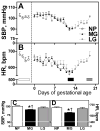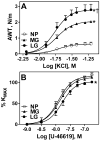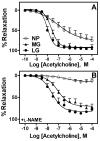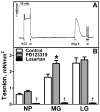Role of the AT2 receptor in modulating the angiotensin II contractile response of the uterine artery at mid-gestation
- PMID: 21421654
- PMCID: PMC3126868
- DOI: 10.1177/1470320310397406
Role of the AT2 receptor in modulating the angiotensin II contractile response of the uterine artery at mid-gestation
Abstract
Introduction: During human pregnancy, circulating concentrations of components of the renin-angiotensin system increase, but pressor refractoriness to angiotensin II (Ang-II) is observed. Given the importance of the Ang-II pressor response in deciding susceptibility to preeclampsia and of the Ang-II system for controlling uterine vasoreactivity, we sought to address the effects of pregnancy on the reactivity of the isolated uterine artery (UA) in mice.
Materials and methods: Blood pressure was measured throughout pregnancy in awake C57BL/6J mice. UA segments were isolated from three groups of animals (non-pregnant, mid [day 12-13] and late [day 18-19] gestation) and studied by wire myography.
Results: UA diameters, KCl-mediated responses, and acetylcholine-dependent vasorelaxation were greater at mid and late gestation than in non-pregnant animals. Ang-II responses were also greater during pregnancy, with an increased contraction in response to AT2 receptor blockade at mid-gestation. AT1 receptor blockade abolished the Ang-II response in all groups.
Conclusions: Study findings are consistent with the possibility that AT2 receptor-mediated vasodilatation plays a role in modulating Ang-II contractile responses in pregnancy.
Figures





Similar articles
-
Increased angiotensin II contraction of the uterine artery at early gestation in a transgenic model of hypertensive pregnancy is reduced by inhibition of endocannabinoid hydrolysis.Hypertension. 2014 Sep;64(3):619-25. doi: 10.1161/HYPERTENSIONAHA.114.03633. Epub 2014 Jun 16. Hypertension. 2014. PMID: 24935942 Free PMC article.
-
Differential sensitivity to angiotensin II and norepinephrine in human uterine arteries.J Clin Endocrinol Metab. 2012 Jan;97(1):138-47. doi: 10.1210/jc.2011-1818. Epub 2011 Oct 26. J Clin Endocrinol Metab. 2012. PMID: 22031522 Free PMC article.
-
Facilitation by the renin-angiotensin system of cyclosporine-evoked hypertension in rats: Role of arterial baroreflexes and vasoreactivity.Life Sci. 2016 Oct 15;163:1-10. doi: 10.1016/j.lfs.2016.08.024. Epub 2016 Aug 26. Life Sci. 2016. PMID: 27575704
-
Angiotensin II-induced vascular dysfunction is mediated by the AT1A receptor in mice.Hypertension. 2004 May;43(5):1074-9. doi: 10.1161/01.HYP.0000123074.89717.3d. Epub 2004 Mar 8. Hypertension. 2004. PMID: 15007032
-
Angiotensin II-induced vasodilation via type 2 receptor: role of bradykinin and nitric oxide.Int Immunopharmacol. 2008 Feb;8(2):312-8. doi: 10.1016/j.intimp.2007.06.012. Epub 2007 Jul 19. Int Immunopharmacol. 2008. PMID: 18182246 Review.
Cited by
-
Pregnancy upregulates angiotensin type 2 receptor expression and increases blood flow in uterine arteries of rats.Biol Reprod. 2018 Nov 1;99(5):1091-1099. doi: 10.1093/biolre/ioy130. Biol Reprod. 2018. PMID: 29860295 Free PMC article.
-
Transfer of regulatory T cells into abortion-prone mice promotes the expansion of uterine mast cells and normalizes early pregnancy angiogenesis.Sci Rep. 2015 Sep 10;5:13938. doi: 10.1038/srep13938. Sci Rep. 2015. PMID: 26355667 Free PMC article.
-
Impact of AT2-receptor stimulation on vascular biology, kidney function, and blood pressure.Integr Blood Press Control. 2013 Nov 22;6:153-61. doi: 10.2147/IBPC.S34425. Integr Blood Press Control. 2013. PMID: 24379697 Free PMC article. Review.
-
Protein restriction to pregnant rats increases the plasma levels of angiotensin II and expression of angiotensin II receptors in uterine arteries.Biol Reprod. 2012 Mar 19;86(3):68. doi: 10.1095/biolreprod.111.095844. Print 2012 Mar. Biol Reprod. 2012. PMID: 22088913 Free PMC article.
-
Estrogen Receptor-β Mediates Estradiol-Induced Pregnancy-Specific Uterine Artery Endothelial Cell Angiotensin Type-2 Receptor Expression.Hypertension. 2019 Oct;74(4):967-974. doi: 10.1161/HYPERTENSIONAHA.119.13429. Epub 2019 Aug 5. Hypertension. 2019. PMID: 31378106 Free PMC article.
References
-
- Curran-Everett D, Morris KG, Jr, Moore LG. Regional circulatory contributions to increased systemic vascular conductance of pregnancy. Am J Physiol Heart Circ Physiol. 1991;261(6):H1842–H1847. - PubMed
-
- Palmer SK, Zamudio S, Coffin C, Parker S, Stamm E, Moore LG. Quantitative estimation of human uterine artery blood flow and pelvic blood flow redistribution in pregnancy. Obstet Gynecol. 1992;80(6):1000–1006. - PubMed
-
- Thaler I, Manor D, Itskovitz J, Rottem S, Levit N, Timor-Tritsch I, et al. Changes in uterine blood flow during human pregnancy. Am J Obstet Gynecol. 1990;162:121–125. - PubMed
-
- Rosenfeld CR. Distribution of cardiac output in ovine pregnancy. Am J Physiol Heart Circ Physiol. 1977;232(3):H231–H235. - PubMed
-
- Mu J, Adamson SL. Developmental changes in hemodynamics of uterine artery, utero-and umbilicoplacental, and vitelline circulations in mouse throughout gestation. Am J Physiol Heart Circ Physiol. 2006;291(3):H1421–H1428. - PubMed
Publication types
MeSH terms
Substances
Grants and funding
LinkOut - more resources
Full Text Sources
Research Materials
Miscellaneous

